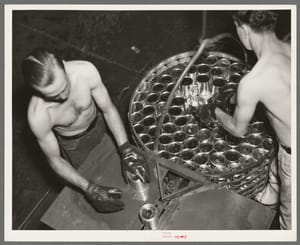The thing that blows my mind about canned food is that canning existed for more than seventy-five years before the can opener was invented.
I did a little canning in my younger years, though of course I really mean “jarring.” It was the peak of summer, and more than anything else I remember the tomatoes. I believe I grilled them quickly to remove the skins, and I also believe that they didn’t stay in the cans for more than a few weeks. It had been a lot of work, done on a hot day, with liberal amounts of steam coming off of the canning bath, and also running outside to tend the grill. And then… impatience, on my part, twisting the jars’ rings back off while it was still summer, that counterclockwise motion, the pop the lid makes as it comes off, and the tomatoes really were amazing. But I could never bring myself to do it all again again.
This was all before I lived in the city, and before I personally packed thousands of funny little FM radios into thousands of squat little mason jars. But that is a story for another day.
How canning works: You want your food to be dead, so that you can store it for an indefinite amount of time. You may want to cook it first, breaking down its cell walls and causing a bunch of chemical reactions that make it more palatable, or maybe you want to keep it more or less raw, like a pickle, so that it’s crisp when you eat it, rather than mushy. Either way you need to kill off any living parts with heat (usually with boiling water at home, with steam in industrial settings) and then seal it into a (relatively) inert container. Then it sits there on your shelf.
The cans in question – the ones in the picture above – contain peas, grown in southern Wisconsin in the summer of 1937. I’m not sure where the cans themselves came from, but here they are being unloaded from a boxcar, into which they have been stacked on their sides. Here the cans are being filled with peas, weaving this way and that in a machine whose horizontal surfaces are scattered with little fugitive spheroids, its operator apparently happy with how the work is going. And here the filled and capped cans are loaded into steam pressure cookers, where they’ll sit for “twenty or thirty minutes” and then emerge, animation properly suspended, and ready for storage. Or immediate consumption, if that’s your style.
SOURCES/SCOPE CREEP.
Read the full story
The rest of this post is for paid members only. Sign up now to read the full post — and all of Scope of Work’s other paid posts.
Sign up now

